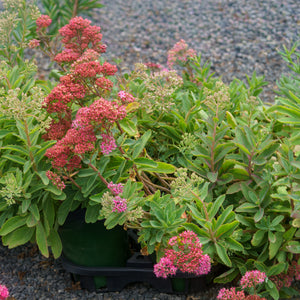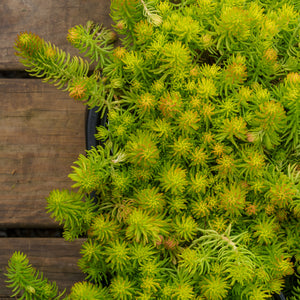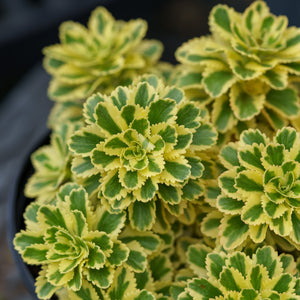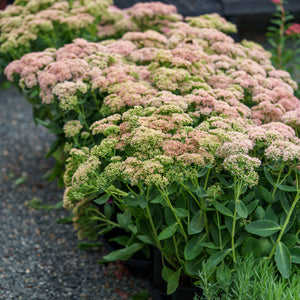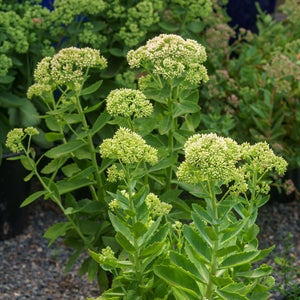The Sedum Guide
Sedum, commonly referred to as stonecrop, is a diverse and hardy genus of succulents and perennials known for their fleshy leaves, vibrant blooms, and exceptional drought tolerance. Whether grown in sunny borders, rock gardens, green roofs, or containers, sedums add low-maintenance structure and long-lasting color throughout the growing season. With options ranging from creeping groundcovers to upright clump-forming varieties, sedums are as functional as they are beautiful.
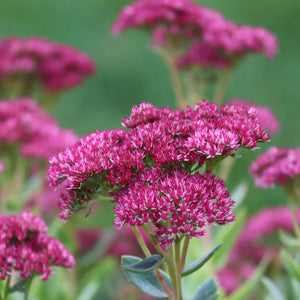
About
Sedum belongs to the Crassulaceae family and includes over 400 recognized species, making it one of the most varied and adaptable genera in ornamental horticulture. These plants are native to Europe, Asia, and North America and thrive in dry, sunny environments with poor soils.
- Groundcovers like Sedum spurium 'John Creech', 'Dragon's Blood', and 'Tricolor' are excellent for filling gaps in pathways and rock gardens.
- Variegated selections such as Sedum kamtschaticum 'Variegatum', 'Atlantis', and 'Lime Twister' provide both color and texture across seasons.
- Upright types like Sedum 'Autumn Joy', 'Matrona', 'Back in Black', and 'Autumn Fire' offer sturdy blooms that attract pollinators and serve as fall focal points.
- The Sunsparkler and Sedoro series—such as 'Blue Elf' and 'Jade Tuffet'—deliver compact, colorful options with unique foliage and vibrant flowers.
- Rare varieties like Sedum globosum 'Old Man’s Bones' and Sedum dasyphyllum 'Himalayan Skies' appeal to collectors and alpine gardeners.
Because of their adaptability and wide range of habits, sedums are used in settings from xeriscapes and rooftop gardens to borders and containers.

PLANTING
Planting sedum is straightforward and rewards the gardener with years of carefree growth:
- USDA Hardiness Zones: Most sedum varieties are hardy in Zones 3–9, depending on species.
- Soil: Sharp-draining, sandy or rocky soils are best. Avoid heavy clay or wet conditions.
- Sunlight: Full sun is ideal for strong growth and maximum flowering. Some low-light tolerance exists among groundcover forms.
- Spacing: Space low-growing sedums 6–12 inches apart. Upright types should be spaced 12–18 inches apart.
- Planting Time: Spring through early fall is suitable for planting. Fall planting gives time for roots to settle before winter.
To plant, dig a shallow hole, set the plant just above soil level, backfill lightly, and water deeply. Sedum requires minimal amendment if the soil is already well-drained.

CARE
Sedum is among the easiest perennials to maintain and thrives on neglect:
- Watering: Water occasionally until established. Once mature, most sedum varieties are drought-tolerant and only need water during extended dry periods.
- Fertilizing: Avoid high-nitrogen fertilizers, which cause leggy growth. A light application of compost in spring is sufficient.
- Pruning: Cut back upright types in late fall or early spring. Groundcovers can be sheared lightly to maintain shape.
- Division: Groundcovers can be divided in spring. Upright sedums can be split every few years to rejuvenate clumps.
- Pests & Diseases: Generally pest- and disease-free. Overwatering may lead to root rot or mildew.
With minimal effort, sedums continue to flourish year after year in tough garden spots.

HOW TO USE
Sedum’s versatility allows it to fill multiple roles in the garden:
- Groundcovers & Green Roofs: Spreading types like 'Angelina', 'Red Ice', and 'Fuldaglut' cover soil and suppress weeds with ease.
- Rock Gardens & Edging: Compact selections such as 'Cape Blanco' and 'Boogie Woogie' thrive in crevices and along pathways.
- Pollinator Beds: Tall varieties like 'Autumn Joy' and 'Carl' offer late-season nectar for bees and butterflies.
- Container Gardens: Sedums pair beautifully with echeveria, sempervivum, and succulents in pots and troughs.
- Seasonal Interest: Varieties like 'Dark Magic' and 'Night Embers' offer dark foliage and strong floral contrast late into the season.
Try combining upright sedums with ornamental grasses, echinacea, rudbeckia, or coreopsis to create layered, drought-tolerant planting schemes.

COMMON QUESTIONS
- Do deer eat sedum? Sedum is typically deer resistant due to its succulent leaves and bitter sap.
- How to propagate sedum? Sedums are easily propagated from stem cuttings, leaf cuttings, or division. Most spread naturally over time.
- Is sedum poisonous to dogs? Most sedums are non-toxic to dogs, though ingestion may occasionally cause mild stomach upset.
- Is sedum poisonous to cats? Sedum is generally considered non-toxic to cats but may cause minor digestive irritation if ingested in large amounts.
- Is sedum a perennial? Yes, most sedum species and cultivars are hardy perennials.
- Does sedum spread? Many types spread through runners or self-seeding. Groundcovers like 'Coral Carpet' and 'Ogon' are fast-spreading.
- Is sedum invasive? While not typically invasive, some species like Sedum acre can spread aggressively under ideal conditions.
Conclusion
Sedum delivers year-round interest, incredible durability, and wide aesthetic appeal. Whether you’re planting an alpine trough, designing a pollinator border, or building a water-wise garden, sedum’s variety and versatility make it a go-to solution. From the chartreuse tones of 'Ogon' to the rich pink flowers of 'Cherry Tart' and the stately presence of 'Matrona', there’s a sedum for every situation.
The Sedum Collection
Sold Out
Sold Out

